Civil Engineering Report: Precast Concrete Systems and Waste Reduction
VerifiedAdded on 2020/03/02
|8
|2598
|94
Report
AI Summary
This report examines precast concrete systems, focusing on their application in reducing waste within the construction industry. It highlights the limitations of traditional construction methods in waste control and emphasizes the advantages of precast concrete, which minimizes waste through off-site construction processes. The report analyzes two primary precast concrete methods: fully precast and partial precast systems, detailing their respective applications and suitability for different construction scenarios. It delves into the needs definition, functional analysis, and trade-off analysis of these systems, presenting quantitative data on technical performance measures such as element weight, waste reduction, maintainability, and cost-effectiveness. The analysis includes a functional flow block diagram and compares the two main approaches, providing a conclusion and recommendation on the optimal use of precast concrete systems based on project size and requirements, emphasizing their economic and environmental benefits.

RUNNING HEAD: SYSTEMS SCIENCE ENGINEERING
NAME
STUDENT NUMBER
UNIT NUMBER
ASSESSMENT NUMBER
i
NAME
STUDENT NUMBER
UNIT NUMBER
ASSESSMENT NUMBER
i
Paraphrase This Document
Need a fresh take? Get an instant paraphrase of this document with our AI Paraphraser

RUNNING HEAD: SYSTEMS SCIENCE ENGINEERING
EXECUTIVE SUMMARY
There has been a need to reduce wastages in the construction industry with regular construction
systems offering little to waste control measures. These wastes lead to high costs during construction
and also contribute largely to environmental degradation. With this in mind, the precast concrete
construction system has become a very instrumental system of construction. Although the design does
not vary much from that of regular constructions, the construction (operation) process changes
significantly reduces the wastages owing to the off-site manner of construction in minimal wastage
industrial processes. 2 methods of the precast concrete construction (fully precast concrete systems
and partial precast concrete systems) are analyzed with both having better application in different
situations.
i
EXECUTIVE SUMMARY
There has been a need to reduce wastages in the construction industry with regular construction
systems offering little to waste control measures. These wastes lead to high costs during construction
and also contribute largely to environmental degradation. With this in mind, the precast concrete
construction system has become a very instrumental system of construction. Although the design does
not vary much from that of regular constructions, the construction (operation) process changes
significantly reduces the wastages owing to the off-site manner of construction in minimal wastage
industrial processes. 2 methods of the precast concrete construction (fully precast concrete systems
and partial precast concrete systems) are analyzed with both having better application in different
situations.
i

RUNNING HEAD: SYSTEMS SCIENCE ENGINEERING
TABLE OF CONTENTS:
EXECUTIVE SUMMARY......................................................................................................................i
INTRODUCTION...................................................................................................................................1
NEEDS DEFINITION.............................................................................................................................1
FUNCTIONAL ANALYSIS...................................................................................................................2
TRADEOFF ANALYSIS........................................................................................................................3
CONCLUSION........................................................................................................................................4
RECOMMENDATION...........................................................................................................................4
REFERENCES........................................................................................................................................5
ii
TABLE OF CONTENTS:
EXECUTIVE SUMMARY......................................................................................................................i
INTRODUCTION...................................................................................................................................1
NEEDS DEFINITION.............................................................................................................................1
FUNCTIONAL ANALYSIS...................................................................................................................2
TRADEOFF ANALYSIS........................................................................................................................3
CONCLUSION........................................................................................................................................4
RECOMMENDATION...........................................................................................................................4
REFERENCES........................................................................................................................................5
ii
⊘ This is a preview!⊘
Do you want full access?
Subscribe today to unlock all pages.

Trusted by 1+ million students worldwide
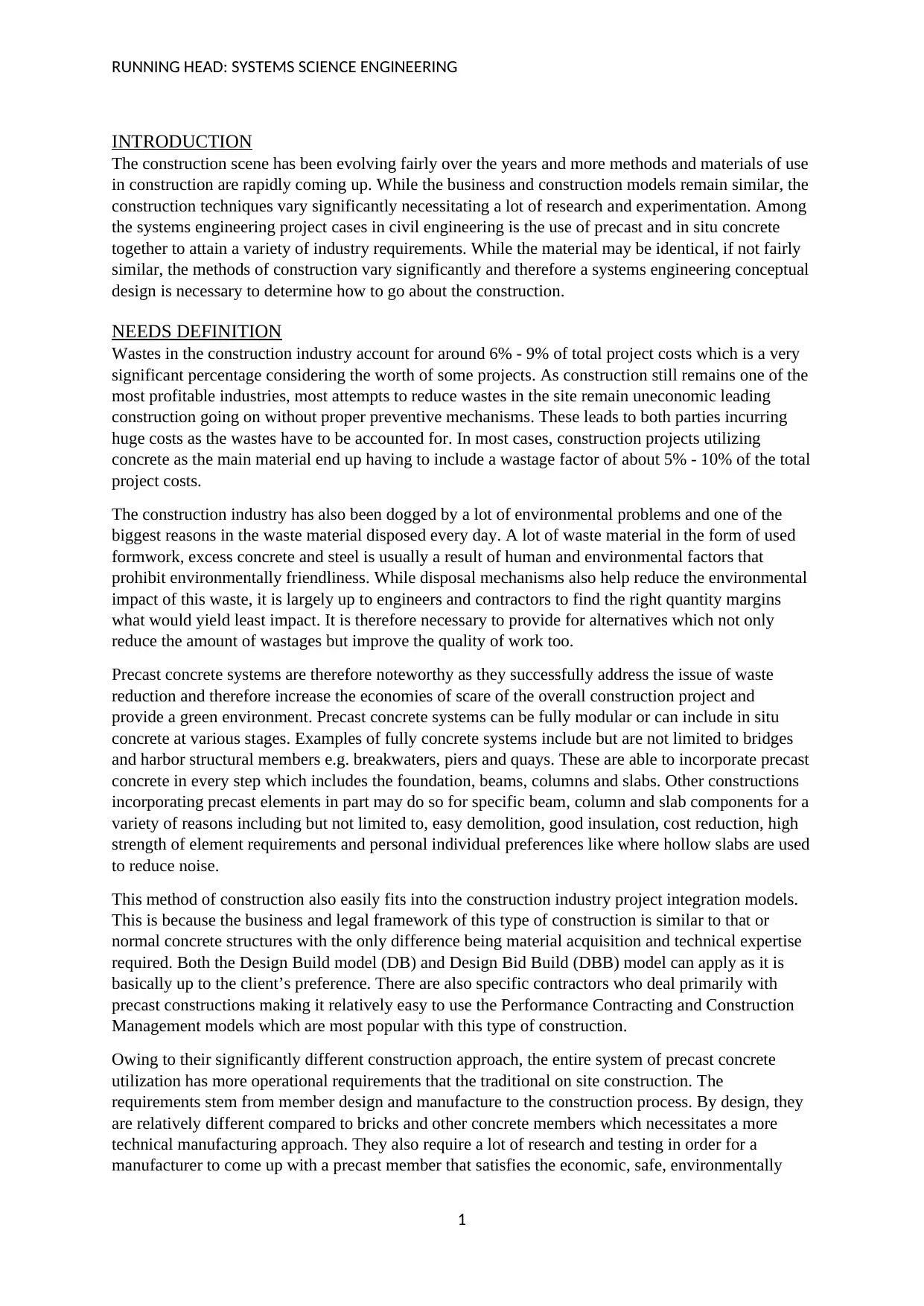
RUNNING HEAD: SYSTEMS SCIENCE ENGINEERING
INTRODUCTION
The construction scene has been evolving fairly over the years and more methods and materials of use
in construction are rapidly coming up. While the business and construction models remain similar, the
construction techniques vary significantly necessitating a lot of research and experimentation. Among
the systems engineering project cases in civil engineering is the use of precast and in situ concrete
together to attain a variety of industry requirements. While the material may be identical, if not fairly
similar, the methods of construction vary significantly and therefore a systems engineering conceptual
design is necessary to determine how to go about the construction.
NEEDS DEFINITION
Wastes in the construction industry account for around 6% - 9% of total project costs which is a very
significant percentage considering the worth of some projects. As construction still remains one of the
most profitable industries, most attempts to reduce wastes in the site remain uneconomic leading
construction going on without proper preventive mechanisms. These leads to both parties incurring
huge costs as the wastes have to be accounted for. In most cases, construction projects utilizing
concrete as the main material end up having to include a wastage factor of about 5% - 10% of the total
project costs.
The construction industry has also been dogged by a lot of environmental problems and one of the
biggest reasons in the waste material disposed every day. A lot of waste material in the form of used
formwork, excess concrete and steel is usually a result of human and environmental factors that
prohibit environmentally friendliness. While disposal mechanisms also help reduce the environmental
impact of this waste, it is largely up to engineers and contractors to find the right quantity margins
what would yield least impact. It is therefore necessary to provide for alternatives which not only
reduce the amount of wastages but improve the quality of work too.
Precast concrete systems are therefore noteworthy as they successfully address the issue of waste
reduction and therefore increase the economies of scare of the overall construction project and
provide a green environment. Precast concrete systems can be fully modular or can include in situ
concrete at various stages. Examples of fully concrete systems include but are not limited to bridges
and harbor structural members e.g. breakwaters, piers and quays. These are able to incorporate precast
concrete in every step which includes the foundation, beams, columns and slabs. Other constructions
incorporating precast elements in part may do so for specific beam, column and slab components for a
variety of reasons including but not limited to, easy demolition, good insulation, cost reduction, high
strength of element requirements and personal individual preferences like where hollow slabs are used
to reduce noise.
This method of construction also easily fits into the construction industry project integration models.
This is because the business and legal framework of this type of construction is similar to that or
normal concrete structures with the only difference being material acquisition and technical expertise
required. Both the Design Build model (DB) and Design Bid Build (DBB) model can apply as it is
basically up to the client’s preference. There are also specific contractors who deal primarily with
precast constructions making it relatively easy to use the Performance Contracting and Construction
Management models which are most popular with this type of construction.
Owing to their significantly different construction approach, the entire system of precast concrete
utilization has more operational requirements that the traditional on site construction. The
requirements stem from member design and manufacture to the construction process. By design, they
are relatively different compared to bricks and other concrete members which necessitates a more
technical manufacturing approach. They also require a lot of research and testing in order for a
manufacturer to come up with a precast member that satisfies the economic, safe, environmentally
1
INTRODUCTION
The construction scene has been evolving fairly over the years and more methods and materials of use
in construction are rapidly coming up. While the business and construction models remain similar, the
construction techniques vary significantly necessitating a lot of research and experimentation. Among
the systems engineering project cases in civil engineering is the use of precast and in situ concrete
together to attain a variety of industry requirements. While the material may be identical, if not fairly
similar, the methods of construction vary significantly and therefore a systems engineering conceptual
design is necessary to determine how to go about the construction.
NEEDS DEFINITION
Wastes in the construction industry account for around 6% - 9% of total project costs which is a very
significant percentage considering the worth of some projects. As construction still remains one of the
most profitable industries, most attempts to reduce wastes in the site remain uneconomic leading
construction going on without proper preventive mechanisms. These leads to both parties incurring
huge costs as the wastes have to be accounted for. In most cases, construction projects utilizing
concrete as the main material end up having to include a wastage factor of about 5% - 10% of the total
project costs.
The construction industry has also been dogged by a lot of environmental problems and one of the
biggest reasons in the waste material disposed every day. A lot of waste material in the form of used
formwork, excess concrete and steel is usually a result of human and environmental factors that
prohibit environmentally friendliness. While disposal mechanisms also help reduce the environmental
impact of this waste, it is largely up to engineers and contractors to find the right quantity margins
what would yield least impact. It is therefore necessary to provide for alternatives which not only
reduce the amount of wastages but improve the quality of work too.
Precast concrete systems are therefore noteworthy as they successfully address the issue of waste
reduction and therefore increase the economies of scare of the overall construction project and
provide a green environment. Precast concrete systems can be fully modular or can include in situ
concrete at various stages. Examples of fully concrete systems include but are not limited to bridges
and harbor structural members e.g. breakwaters, piers and quays. These are able to incorporate precast
concrete in every step which includes the foundation, beams, columns and slabs. Other constructions
incorporating precast elements in part may do so for specific beam, column and slab components for a
variety of reasons including but not limited to, easy demolition, good insulation, cost reduction, high
strength of element requirements and personal individual preferences like where hollow slabs are used
to reduce noise.
This method of construction also easily fits into the construction industry project integration models.
This is because the business and legal framework of this type of construction is similar to that or
normal concrete structures with the only difference being material acquisition and technical expertise
required. Both the Design Build model (DB) and Design Bid Build (DBB) model can apply as it is
basically up to the client’s preference. There are also specific contractors who deal primarily with
precast constructions making it relatively easy to use the Performance Contracting and Construction
Management models which are most popular with this type of construction.
Owing to their significantly different construction approach, the entire system of precast concrete
utilization has more operational requirements that the traditional on site construction. The
requirements stem from member design and manufacture to the construction process. By design, they
are relatively different compared to bricks and other concrete members which necessitates a more
technical manufacturing approach. They also require a lot of research and testing in order for a
manufacturer to come up with a precast member that satisfies the economic, safe, environmentally
1
Paraphrase This Document
Need a fresh take? Get an instant paraphrase of this document with our AI Paraphraser
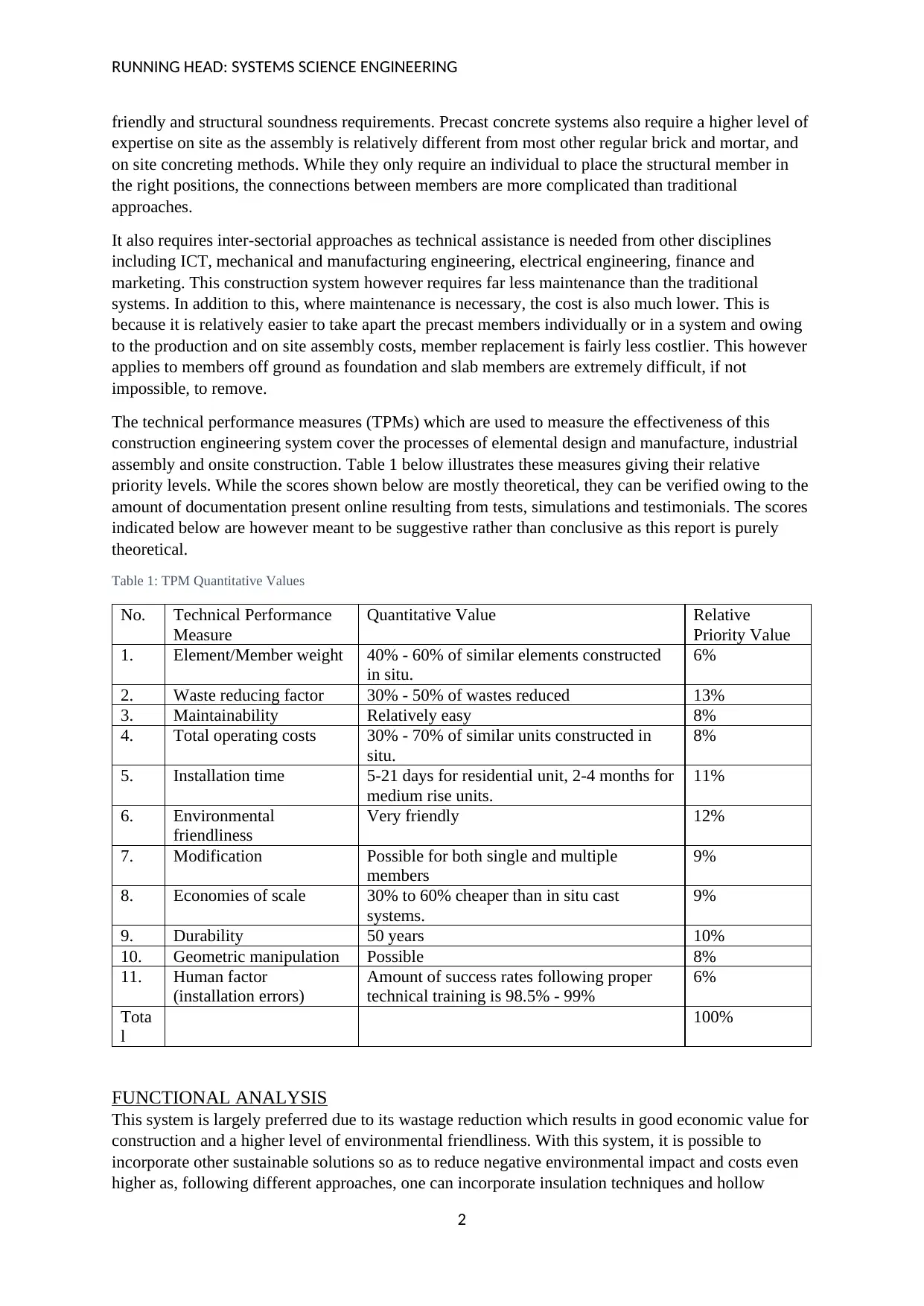
RUNNING HEAD: SYSTEMS SCIENCE ENGINEERING
friendly and structural soundness requirements. Precast concrete systems also require a higher level of
expertise on site as the assembly is relatively different from most other regular brick and mortar, and
on site concreting methods. While they only require an individual to place the structural member in
the right positions, the connections between members are more complicated than traditional
approaches.
It also requires inter-sectorial approaches as technical assistance is needed from other disciplines
including ICT, mechanical and manufacturing engineering, electrical engineering, finance and
marketing. This construction system however requires far less maintenance than the traditional
systems. In addition to this, where maintenance is necessary, the cost is also much lower. This is
because it is relatively easier to take apart the precast members individually or in a system and owing
to the production and on site assembly costs, member replacement is fairly less costlier. This however
applies to members off ground as foundation and slab members are extremely difficult, if not
impossible, to remove.
The technical performance measures (TPMs) which are used to measure the effectiveness of this
construction engineering system cover the processes of elemental design and manufacture, industrial
assembly and onsite construction. Table 1 below illustrates these measures giving their relative
priority levels. While the scores shown below are mostly theoretical, they can be verified owing to the
amount of documentation present online resulting from tests, simulations and testimonials. The scores
indicated below are however meant to be suggestive rather than conclusive as this report is purely
theoretical.
Table 1: TPM Quantitative Values
No. Technical Performance
Measure
Quantitative Value Relative
Priority Value
1. Element/Member weight 40% - 60% of similar elements constructed
in situ.
6%
2. Waste reducing factor 30% - 50% of wastes reduced 13%
3. Maintainability Relatively easy 8%
4. Total operating costs 30% - 70% of similar units constructed in
situ.
8%
5. Installation time 5-21 days for residential unit, 2-4 months for
medium rise units.
11%
6. Environmental
friendliness
Very friendly 12%
7. Modification Possible for both single and multiple
members
9%
8. Economies of scale 30% to 60% cheaper than in situ cast
systems.
9%
9. Durability 50 years 10%
10. Geometric manipulation Possible 8%
11. Human factor
(installation errors)
Amount of success rates following proper
technical training is 98.5% - 99%
6%
Tota
l
100%
FUNCTIONAL ANALYSIS
This system is largely preferred due to its wastage reduction which results in good economic value for
construction and a higher level of environmental friendliness. With this system, it is possible to
incorporate other sustainable solutions so as to reduce negative environmental impact and costs even
higher as, following different approaches, one can incorporate insulation techniques and hollow
2
friendly and structural soundness requirements. Precast concrete systems also require a higher level of
expertise on site as the assembly is relatively different from most other regular brick and mortar, and
on site concreting methods. While they only require an individual to place the structural member in
the right positions, the connections between members are more complicated than traditional
approaches.
It also requires inter-sectorial approaches as technical assistance is needed from other disciplines
including ICT, mechanical and manufacturing engineering, electrical engineering, finance and
marketing. This construction system however requires far less maintenance than the traditional
systems. In addition to this, where maintenance is necessary, the cost is also much lower. This is
because it is relatively easier to take apart the precast members individually or in a system and owing
to the production and on site assembly costs, member replacement is fairly less costlier. This however
applies to members off ground as foundation and slab members are extremely difficult, if not
impossible, to remove.
The technical performance measures (TPMs) which are used to measure the effectiveness of this
construction engineering system cover the processes of elemental design and manufacture, industrial
assembly and onsite construction. Table 1 below illustrates these measures giving their relative
priority levels. While the scores shown below are mostly theoretical, they can be verified owing to the
amount of documentation present online resulting from tests, simulations and testimonials. The scores
indicated below are however meant to be suggestive rather than conclusive as this report is purely
theoretical.
Table 1: TPM Quantitative Values
No. Technical Performance
Measure
Quantitative Value Relative
Priority Value
1. Element/Member weight 40% - 60% of similar elements constructed
in situ.
6%
2. Waste reducing factor 30% - 50% of wastes reduced 13%
3. Maintainability Relatively easy 8%
4. Total operating costs 30% - 70% of similar units constructed in
situ.
8%
5. Installation time 5-21 days for residential unit, 2-4 months for
medium rise units.
11%
6. Environmental
friendliness
Very friendly 12%
7. Modification Possible for both single and multiple
members
9%
8. Economies of scale 30% to 60% cheaper than in situ cast
systems.
9%
9. Durability 50 years 10%
10. Geometric manipulation Possible 8%
11. Human factor
(installation errors)
Amount of success rates following proper
technical training is 98.5% - 99%
6%
Tota
l
100%
FUNCTIONAL ANALYSIS
This system is largely preferred due to its wastage reduction which results in good economic value for
construction and a higher level of environmental friendliness. With this system, it is possible to
incorporate other sustainable solutions so as to reduce negative environmental impact and costs even
higher as, following different approaches, one can incorporate insulation techniques and hollow
2
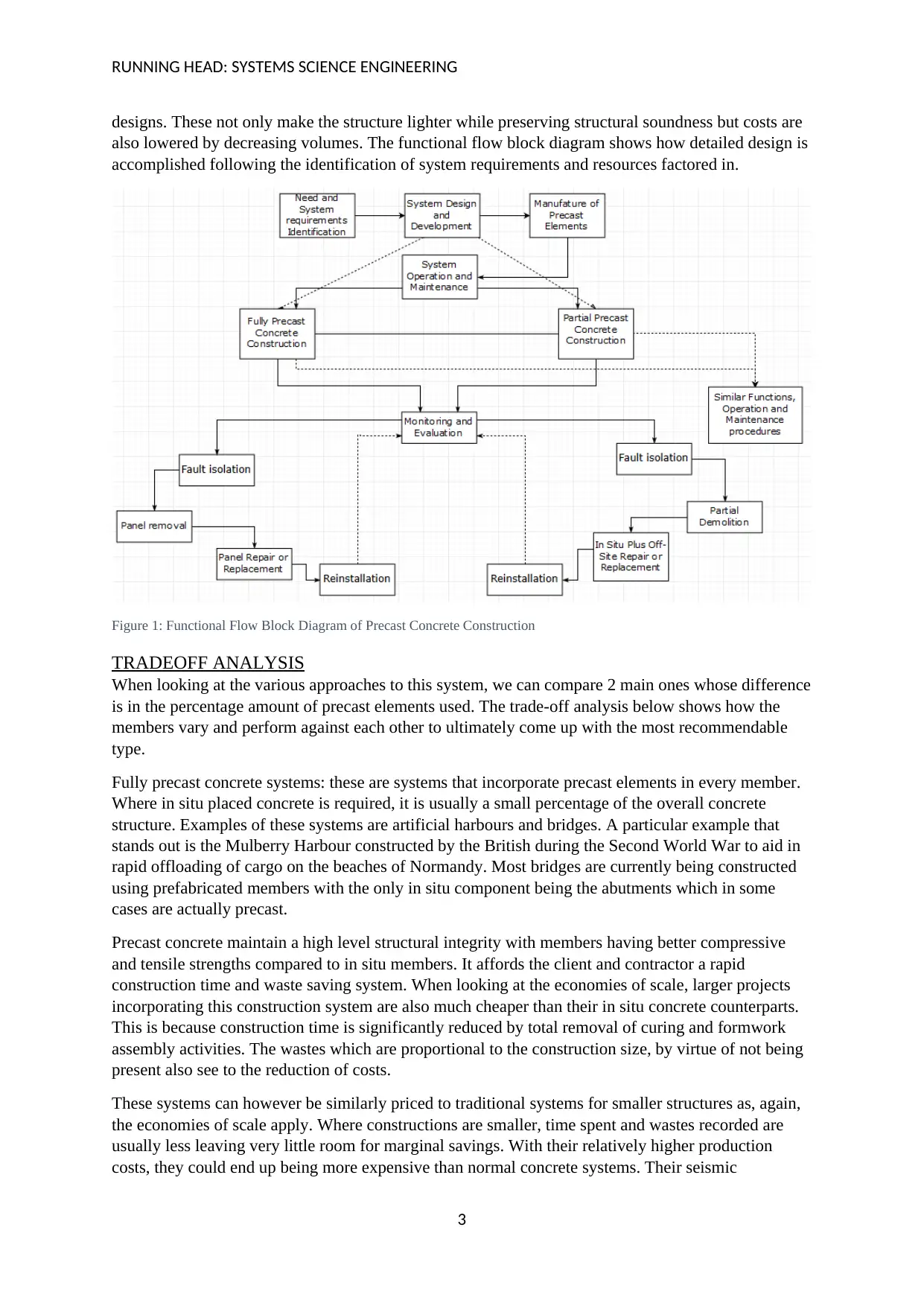
RUNNING HEAD: SYSTEMS SCIENCE ENGINEERING
designs. These not only make the structure lighter while preserving structural soundness but costs are
also lowered by decreasing volumes. The functional flow block diagram shows how detailed design is
accomplished following the identification of system requirements and resources factored in.
Figure 1: Functional Flow Block Diagram of Precast Concrete Construction
TRADEOFF ANALYSIS
When looking at the various approaches to this system, we can compare 2 main ones whose difference
is in the percentage amount of precast elements used. The trade-off analysis below shows how the
members vary and perform against each other to ultimately come up with the most recommendable
type.
Fully precast concrete systems: these are systems that incorporate precast elements in every member.
Where in situ placed concrete is required, it is usually a small percentage of the overall concrete
structure. Examples of these systems are artificial harbours and bridges. A particular example that
stands out is the Mulberry Harbour constructed by the British during the Second World War to aid in
rapid offloading of cargo on the beaches of Normandy. Most bridges are currently being constructed
using prefabricated members with the only in situ component being the abutments which in some
cases are actually precast.
Precast concrete maintain a high level structural integrity with members having better compressive
and tensile strengths compared to in situ members. It affords the client and contractor a rapid
construction time and waste saving system. When looking at the economies of scale, larger projects
incorporating this construction system are also much cheaper than their in situ concrete counterparts.
This is because construction time is significantly reduced by total removal of curing and formwork
assembly activities. The wastes which are proportional to the construction size, by virtue of not being
present also see to the reduction of costs.
These systems can however be similarly priced to traditional systems for smaller structures as, again,
the economies of scale apply. Where constructions are smaller, time spent and wastes recorded are
usually less leaving very little room for marginal savings. With their relatively higher production
costs, they could end up being more expensive than normal concrete systems. Their seismic
3
designs. These not only make the structure lighter while preserving structural soundness but costs are
also lowered by decreasing volumes. The functional flow block diagram shows how detailed design is
accomplished following the identification of system requirements and resources factored in.
Figure 1: Functional Flow Block Diagram of Precast Concrete Construction
TRADEOFF ANALYSIS
When looking at the various approaches to this system, we can compare 2 main ones whose difference
is in the percentage amount of precast elements used. The trade-off analysis below shows how the
members vary and perform against each other to ultimately come up with the most recommendable
type.
Fully precast concrete systems: these are systems that incorporate precast elements in every member.
Where in situ placed concrete is required, it is usually a small percentage of the overall concrete
structure. Examples of these systems are artificial harbours and bridges. A particular example that
stands out is the Mulberry Harbour constructed by the British during the Second World War to aid in
rapid offloading of cargo on the beaches of Normandy. Most bridges are currently being constructed
using prefabricated members with the only in situ component being the abutments which in some
cases are actually precast.
Precast concrete maintain a high level structural integrity with members having better compressive
and tensile strengths compared to in situ members. It affords the client and contractor a rapid
construction time and waste saving system. When looking at the economies of scale, larger projects
incorporating this construction system are also much cheaper than their in situ concrete counterparts.
This is because construction time is significantly reduced by total removal of curing and formwork
assembly activities. The wastes which are proportional to the construction size, by virtue of not being
present also see to the reduction of costs.
These systems can however be similarly priced to traditional systems for smaller structures as, again,
the economies of scale apply. Where constructions are smaller, time spent and wastes recorded are
usually less leaving very little room for marginal savings. With their relatively higher production
costs, they could end up being more expensive than normal concrete systems. Their seismic
3
⊘ This is a preview!⊘
Do you want full access?
Subscribe today to unlock all pages.

Trusted by 1+ million students worldwide
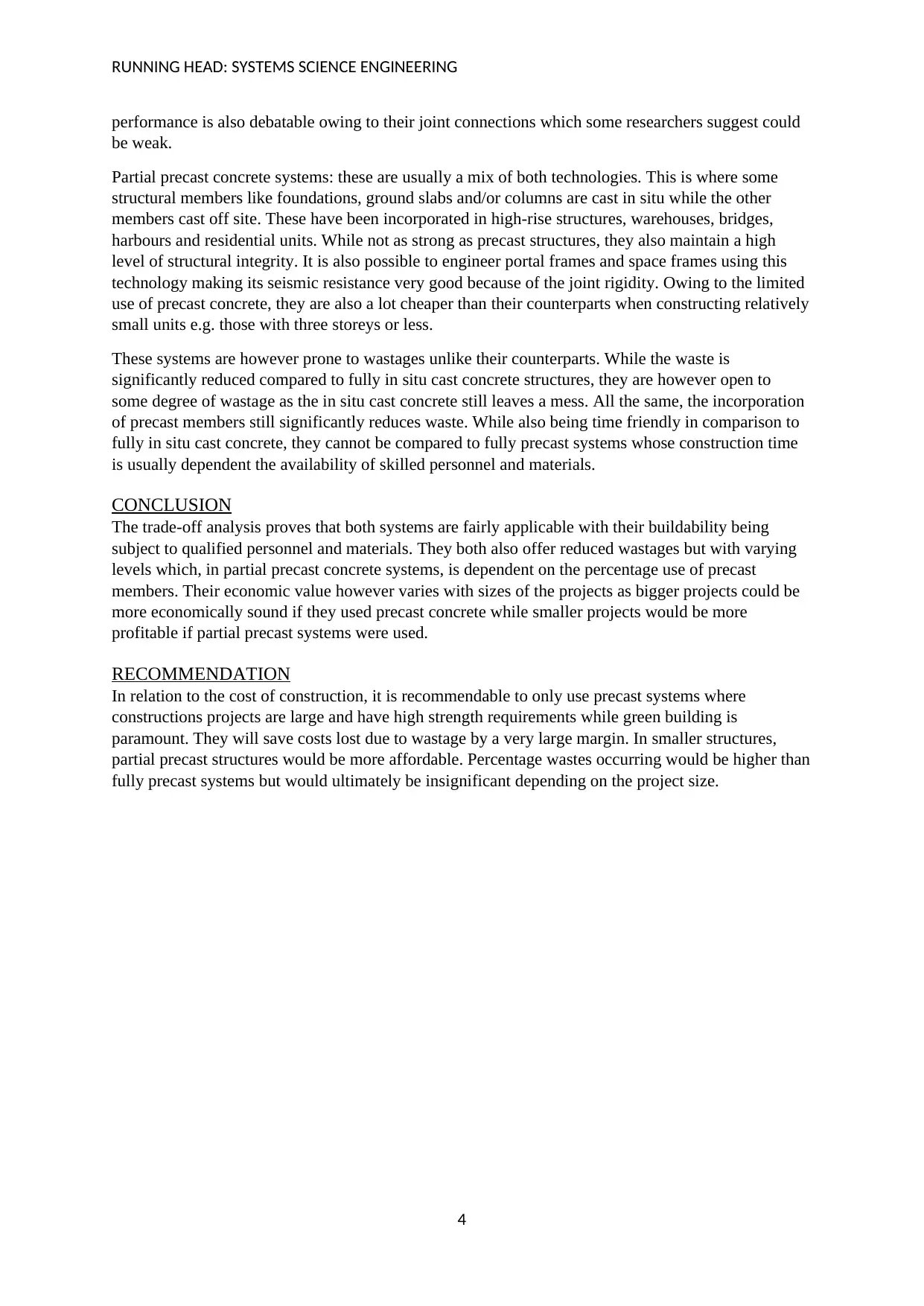
RUNNING HEAD: SYSTEMS SCIENCE ENGINEERING
performance is also debatable owing to their joint connections which some researchers suggest could
be weak.
Partial precast concrete systems: these are usually a mix of both technologies. This is where some
structural members like foundations, ground slabs and/or columns are cast in situ while the other
members cast off site. These have been incorporated in high-rise structures, warehouses, bridges,
harbours and residential units. While not as strong as precast structures, they also maintain a high
level of structural integrity. It is also possible to engineer portal frames and space frames using this
technology making its seismic resistance very good because of the joint rigidity. Owing to the limited
use of precast concrete, they are also a lot cheaper than their counterparts when constructing relatively
small units e.g. those with three storeys or less.
These systems are however prone to wastages unlike their counterparts. While the waste is
significantly reduced compared to fully in situ cast concrete structures, they are however open to
some degree of wastage as the in situ cast concrete still leaves a mess. All the same, the incorporation
of precast members still significantly reduces waste. While also being time friendly in comparison to
fully in situ cast concrete, they cannot be compared to fully precast systems whose construction time
is usually dependent the availability of skilled personnel and materials.
CONCLUSION
The trade-off analysis proves that both systems are fairly applicable with their buildability being
subject to qualified personnel and materials. They both also offer reduced wastages but with varying
levels which, in partial precast concrete systems, is dependent on the percentage use of precast
members. Their economic value however varies with sizes of the projects as bigger projects could be
more economically sound if they used precast concrete while smaller projects would be more
profitable if partial precast systems were used.
RECOMMENDATION
In relation to the cost of construction, it is recommendable to only use precast systems where
constructions projects are large and have high strength requirements while green building is
paramount. They will save costs lost due to wastage by a very large margin. In smaller structures,
partial precast structures would be more affordable. Percentage wastes occurring would be higher than
fully precast systems but would ultimately be insignificant depending on the project size.
4
performance is also debatable owing to their joint connections which some researchers suggest could
be weak.
Partial precast concrete systems: these are usually a mix of both technologies. This is where some
structural members like foundations, ground slabs and/or columns are cast in situ while the other
members cast off site. These have been incorporated in high-rise structures, warehouses, bridges,
harbours and residential units. While not as strong as precast structures, they also maintain a high
level of structural integrity. It is also possible to engineer portal frames and space frames using this
technology making its seismic resistance very good because of the joint rigidity. Owing to the limited
use of precast concrete, they are also a lot cheaper than their counterparts when constructing relatively
small units e.g. those with three storeys or less.
These systems are however prone to wastages unlike their counterparts. While the waste is
significantly reduced compared to fully in situ cast concrete structures, they are however open to
some degree of wastage as the in situ cast concrete still leaves a mess. All the same, the incorporation
of precast members still significantly reduces waste. While also being time friendly in comparison to
fully in situ cast concrete, they cannot be compared to fully precast systems whose construction time
is usually dependent the availability of skilled personnel and materials.
CONCLUSION
The trade-off analysis proves that both systems are fairly applicable with their buildability being
subject to qualified personnel and materials. They both also offer reduced wastages but with varying
levels which, in partial precast concrete systems, is dependent on the percentage use of precast
members. Their economic value however varies with sizes of the projects as bigger projects could be
more economically sound if they used precast concrete while smaller projects would be more
profitable if partial precast systems were used.
RECOMMENDATION
In relation to the cost of construction, it is recommendable to only use precast systems where
constructions projects are large and have high strength requirements while green building is
paramount. They will save costs lost due to wastage by a very large margin. In smaller structures,
partial precast structures would be more affordable. Percentage wastes occurring would be higher than
fully precast systems but would ultimately be insignificant depending on the project size.
4
Paraphrase This Document
Need a fresh take? Get an instant paraphrase of this document with our AI Paraphraser
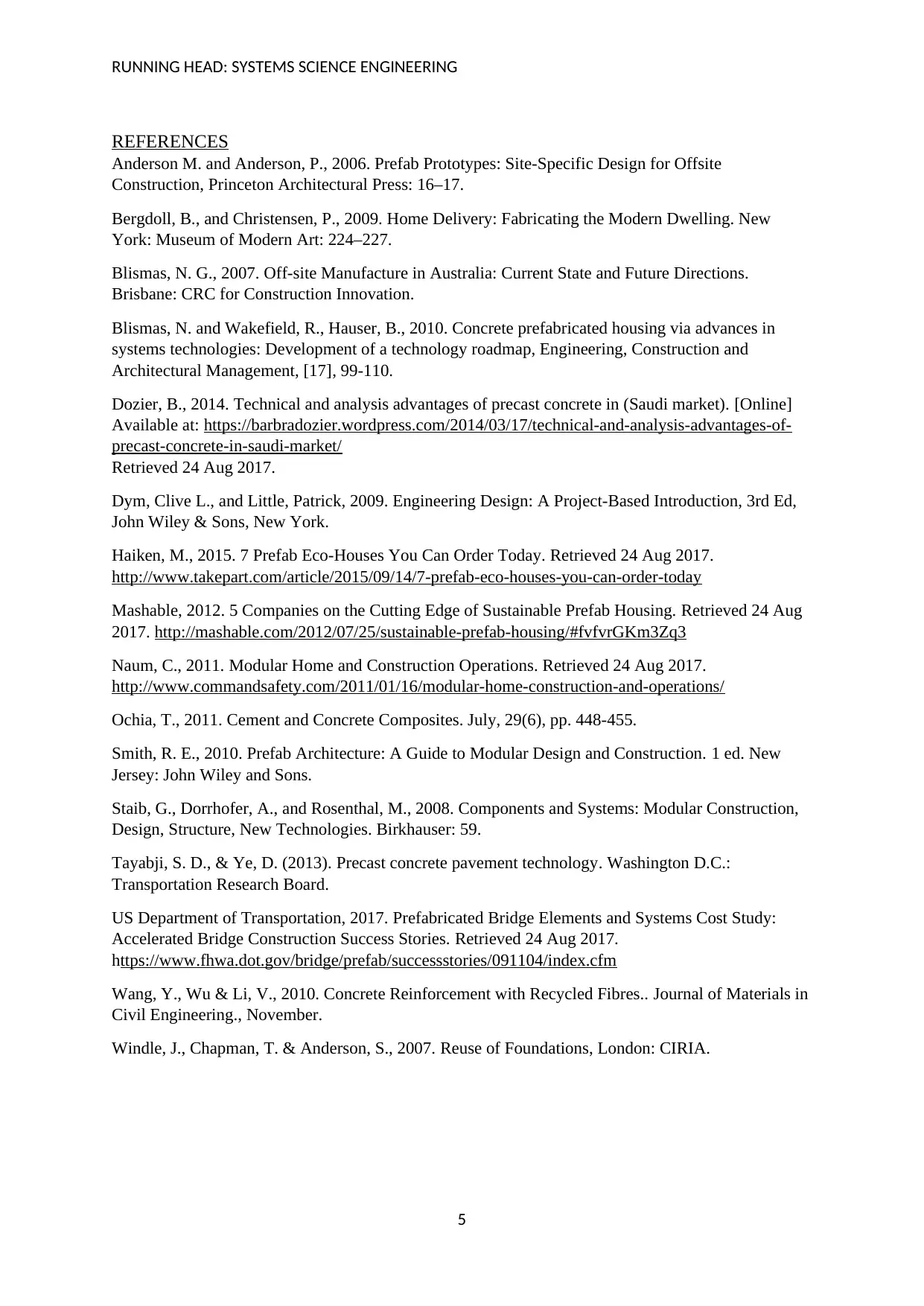
RUNNING HEAD: SYSTEMS SCIENCE ENGINEERING
REFERENCES
Anderson M. and Anderson, P., 2006. Prefab Prototypes: Site-Specific Design for Offsite
Construction, Princeton Architectural Press: 16–17.
Bergdoll, B., and Christensen, P., 2009. Home Delivery: Fabricating the Modern Dwelling. New
York: Museum of Modern Art: 224–227.
Blismas, N. G., 2007. Off-site Manufacture in Australia: Current State and Future Directions.
Brisbane: CRC for Construction Innovation.
Blismas, N. and Wakefield, R., Hauser, B., 2010. Concrete prefabricated housing via advances in
systems technologies: Development of a technology roadmap, Engineering, Construction and
Architectural Management, [17], 99-110.
Dozier, B., 2014. Technical and analysis advantages of precast concrete in (Saudi market). [Online]
Available at: https://barbradozier.wordpress.com/2014/03/17/technical-and-analysis-advantages-of-
precast-concrete-in-saudi-market/
Retrieved 24 Aug 2017.
Dym, Clive L., and Little, Patrick, 2009. Engineering Design: A Project-Based Introduction, 3rd Ed,
John Wiley & Sons, New York.
Haiken, M., 2015. 7 Prefab Eco-Houses You Can Order Today. Retrieved 24 Aug 2017.
http://www.takepart.com/article/2015/09/14/7-prefab-eco-houses-you-can-order-today
Mashable, 2012. 5 Companies on the Cutting Edge of Sustainable Prefab Housing. Retrieved 24 Aug
2017. http://mashable.com/2012/07/25/sustainable-prefab-housing/#fvfvrGKm3Zq3
Naum, C., 2011. Modular Home and Construction Operations. Retrieved 24 Aug 2017.
http://www.commandsafety.com/2011/01/16/modular-home-construction-and-operations/
Ochia, T., 2011. Cement and Concrete Composites. July, 29(6), pp. 448-455.
Smith, R. E., 2010. Prefab Architecture: A Guide to Modular Design and Construction. 1 ed. New
Jersey: John Wiley and Sons.
Staib, G., Dorrhofer, A., and Rosenthal, M., 2008. Components and Systems: Modular Construction,
Design, Structure, New Technologies. Birkhauser: 59.
Tayabji, S. D., & Ye, D. (2013). Precast concrete pavement technology. Washington D.C.:
Transportation Research Board.
US Department of Transportation, 2017. Prefabricated Bridge Elements and Systems Cost Study:
Accelerated Bridge Construction Success Stories. Retrieved 24 Aug 2017.
https://www.fhwa.dot.gov/bridge/prefab/successstories/091104/index.cfm
Wang, Y., Wu & Li, V., 2010. Concrete Reinforcement with Recycled Fibres.. Journal of Materials in
Civil Engineering., November.
Windle, J., Chapman, T. & Anderson, S., 2007. Reuse of Foundations, London: CIRIA.
5
REFERENCES
Anderson M. and Anderson, P., 2006. Prefab Prototypes: Site-Specific Design for Offsite
Construction, Princeton Architectural Press: 16–17.
Bergdoll, B., and Christensen, P., 2009. Home Delivery: Fabricating the Modern Dwelling. New
York: Museum of Modern Art: 224–227.
Blismas, N. G., 2007. Off-site Manufacture in Australia: Current State and Future Directions.
Brisbane: CRC for Construction Innovation.
Blismas, N. and Wakefield, R., Hauser, B., 2010. Concrete prefabricated housing via advances in
systems technologies: Development of a technology roadmap, Engineering, Construction and
Architectural Management, [17], 99-110.
Dozier, B., 2014. Technical and analysis advantages of precast concrete in (Saudi market). [Online]
Available at: https://barbradozier.wordpress.com/2014/03/17/technical-and-analysis-advantages-of-
precast-concrete-in-saudi-market/
Retrieved 24 Aug 2017.
Dym, Clive L., and Little, Patrick, 2009. Engineering Design: A Project-Based Introduction, 3rd Ed,
John Wiley & Sons, New York.
Haiken, M., 2015. 7 Prefab Eco-Houses You Can Order Today. Retrieved 24 Aug 2017.
http://www.takepart.com/article/2015/09/14/7-prefab-eco-houses-you-can-order-today
Mashable, 2012. 5 Companies on the Cutting Edge of Sustainable Prefab Housing. Retrieved 24 Aug
2017. http://mashable.com/2012/07/25/sustainable-prefab-housing/#fvfvrGKm3Zq3
Naum, C., 2011. Modular Home and Construction Operations. Retrieved 24 Aug 2017.
http://www.commandsafety.com/2011/01/16/modular-home-construction-and-operations/
Ochia, T., 2011. Cement and Concrete Composites. July, 29(6), pp. 448-455.
Smith, R. E., 2010. Prefab Architecture: A Guide to Modular Design and Construction. 1 ed. New
Jersey: John Wiley and Sons.
Staib, G., Dorrhofer, A., and Rosenthal, M., 2008. Components and Systems: Modular Construction,
Design, Structure, New Technologies. Birkhauser: 59.
Tayabji, S. D., & Ye, D. (2013). Precast concrete pavement technology. Washington D.C.:
Transportation Research Board.
US Department of Transportation, 2017. Prefabricated Bridge Elements and Systems Cost Study:
Accelerated Bridge Construction Success Stories. Retrieved 24 Aug 2017.
https://www.fhwa.dot.gov/bridge/prefab/successstories/091104/index.cfm
Wang, Y., Wu & Li, V., 2010. Concrete Reinforcement with Recycled Fibres.. Journal of Materials in
Civil Engineering., November.
Windle, J., Chapman, T. & Anderson, S., 2007. Reuse of Foundations, London: CIRIA.
5
1 out of 8
Related Documents
Your All-in-One AI-Powered Toolkit for Academic Success.
+13062052269
info@desklib.com
Available 24*7 on WhatsApp / Email
![[object Object]](/_next/static/media/star-bottom.7253800d.svg)
Unlock your academic potential
Copyright © 2020–2025 A2Z Services. All Rights Reserved. Developed and managed by ZUCOL.





